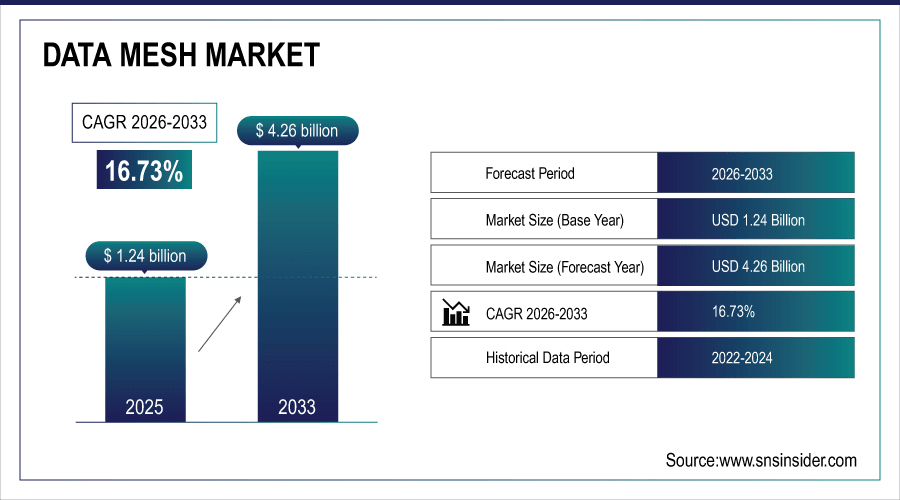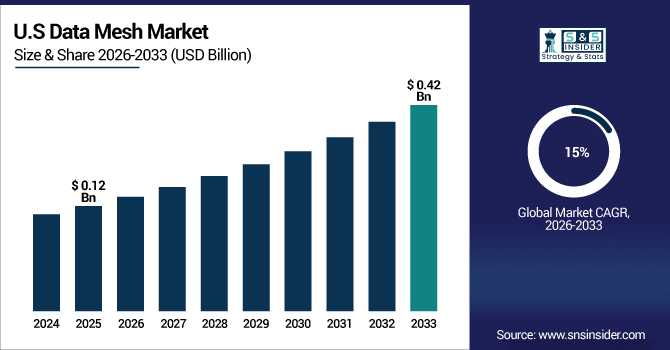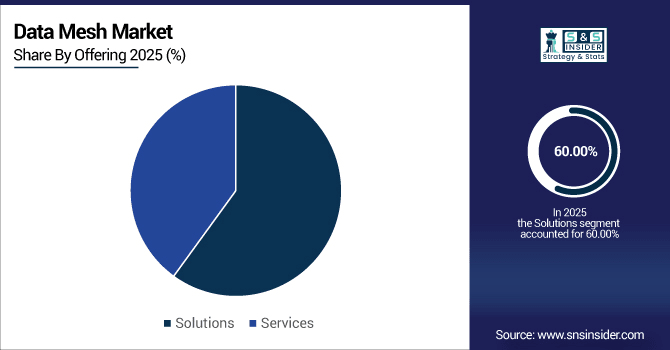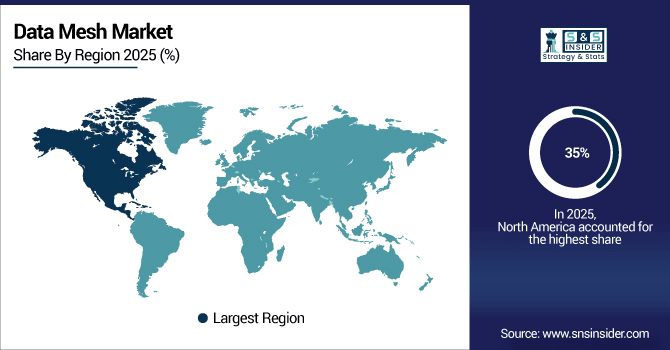Data Mesh Market Report Scope & Overview:
The Data Mesh Market size was valued at USD 1.24 Billion in 2025E and is projected to reach USD 4.26 Billion by 2033, growing at a CAGR of 16.73% during 2026-2033.
The Global Monitoring Tools Market growth is driven by the rising need for proactive system performance management and seamless IT operations across enterprises. Increasing adoption of cloud-based platforms, AI-powered observability, and real-time anomaly detection are boosting demand. Hybrid deployments among solution types enhance scalability, minimize downtime, and improve security posture. Key industries including IT & Telecom, BFSI, healthcare, and manufacturing are major contributors to this adoption across global regions.
In April 2025, Dynatrace announced the expansion of its AI-powered observability platform with advanced anomaly detection and predictive analytics, aiming to support enterprises in reducing downtime and improving digital experience management.

To Get More Information On Data Mesh Market - Request Free Sample Report
Data Mesh Market Trends
-
Growing adoption of domain-oriented decentralized data architecture is helping enterprises reduce data silos and improve decision-making.
-
Cloud-based data mesh deployments are expanding rapidly, with hybrid adoption also gaining strong traction.
-
Rising demand for real-time data accessibility is driving uptake across IT & Telecom and BFSI sectors.
-
Healthcare & Life Sciences organizations are adopting data mesh to strengthen governance and improve interoperability.
-
Increasing interest in hybrid federated mesh approaches is supporting scalability and compliance in regulated industries.
-
Integration of data mesh with AI and machine learning pipelines is enhancing data productization and automation.
-
Growing investments in value-chain-aligned data mesh models are enabling end-to-end visibility in manufacturing and logistics.
The U.S. Data Mesh Market size was valued at USD 0.12 Billion in 2025E and is projected to reach USD 0.42 Billion by 2033, growing at a CAGR of 15% during 2026-2033. The demand for AI-driven data management, real-time analytics, and automated data governance is increasing across IT, healthcare, BFSI, and government sectors. Continuous availability of quality data, proactive discovery of data issues, and optimization of distributed data architectures are driving adoption of data mesh for enterprises, cloud platforms, and digital transformation initiatives.

Data Mesh Market Growth Drivers:
-
Growing Demand for Decentralized and Real-Time Data Access, Bottlenecks in Centralized Architectures Drive Enterprises Toward Data Mesh Adoption
The primary growth driver of the Data Mesh Market is the rising need for decentralized and real-time data access. Traditional centralized data lakes often create bottlenecks, limiting agility and scalability. Data mesh, with its domain-oriented and federated architecture, enables enterprises to democratize data ownership, improve governance, and deliver faster insights. This approach supports AI/ML initiatives, enhances decision-making, and accelerates digital transformation across diverse industries.
In March 2025, Forrester projected that more than 70% of enterprises will adopt federated data governance models to address compliance and scale in data operations.
Data Mesh Market Restraints:
-
High Implementation Complexity and Organizational Challenges, Cultural Shifts and Legacy System Integration Slow Adoption of Data Mesh
The primary restraint for the Data Mesh Market is the high complexity involved in implementation and organizational change. Transitioning from centralized data architectures to a decentralized, domain-oriented model requires redefining data ownership, governance processes, and team responsibilities. Enterprises often face challenges in training staff, integrating legacy systems, and establishing consistent standards across domains. These factors slow adoption and increase the time and cost required to realize the full benefits of data mesh.
Data Mesh Market Opportunities:
-
Decentralized Data Ownership and Domain-Oriented Management, Enabling Faster Decision-Making, Enhanced Agility, and Operational Efficiency Across Enterprises
The primary opportunity in the Data Mesh Market lies in enabling decentralized, domain-oriented data management. By treating data as a product, enterprises empower individual teams to own, manage, and serve their data independently, improving scalability and agility. This approach supports faster decision-making, enhances operational efficiency, and facilitates advanced analytics and AI/ML initiatives. Industries undergoing digital transformation, such as BFSI, healthcare, and IT, stand to benefit the most.
In March 2025, a Forrester study projected that over 70% of enterprises would adopt federated data governance models by 2025, driven by the need for decentralized data architectures that enable scalability, agility, and improved decision-making across large enterprises.
Data Mesh Market Segment Analysis
-
By Offering, Solutions dominated the market, accounting for 60% share in 2025, while Services is the fastest-growing segment, projected to expand at a CAGR of 18% from 2026 to 2033.
-
By Application, Data Privacy Management dominated the market, accounting for 25% share in 2025, while IoT Monitoring is the fastest-growing segment, projected to expand at a CAGR of 20% from 2026 to 2033.
-
By Vertical, Healthcare & Life Sciences dominated the market, accounting for 30% share in 2025, while the same segment is also the fastest-growing, projected to expand at a CAGR of 18% from 2026 to 2033.
-
By Approach, Fine-Grained Mesh dominated the market, accounting for 40% share in 2025, while Hybrid Federated Mesh is the fastest-growing segment, projected to expand at a CAGR of 19% from 2026 to 2033.
By Offering, Solutions lead market share, while Services grow fastest
Solutions dominate the Data Mesh market due to their critical role in implementing domain-oriented data architectures, enabling real-time data access, and ensuring effective data governance across enterprises. Services are emerging as the fastest-growing segment, driven by increasing demand for consulting, integration, and managed support to deploy, maintain, and optimize data mesh frameworks across diverse industries. Adoption of these solutions also helps organizations improve scalability, streamline data operations, and accelerate digital transformation initiatives.

By Application, Data Privacy Management dominates, while IoT Monitoring rises fastest
Data Privacy Management dominates the Data Mesh market due to increasing regulatory requirements and the critical need for secure, compliant handling of sensitive enterprise data. Organizations prioritize protecting data across decentralized architectures, driving widespread adoption of privacy-focused solutions. IoT Monitoring is the fastest-growing segment, fueled by rising deployment of connected devices and sensors across industries, which necessitates real-time data tracking, analytics, and governance to ensure operational efficiency, security, and seamless integration with data mesh frameworks.
By Vertical, Healthcare & Life Sciences hold majority share, growing fastest
Healthcare & Life Sciences dominate the Data Mesh market due to the critical need for secure, interoperable, and real-time access to patient and clinical data across multiple domains. The sector is also the fastest-growing segment, driven by the adoption of advanced analytics, AI/ML applications, and cloud-based data platforms. Implementing data mesh enables healthcare organizations to improve data governance, enhance operational efficiency, accelerate research, and support personalized patient care initiatives.
By Approach, Fine-Grained Mesh leads adoption, while Hybrid Federated Mesh expands fastest
Fine-Grained Mesh dominates the Data Mesh market as it allows detailed control over data ownership, governance, and access within individual domains, ensuring high data quality and operational efficiency. Hybrid Federated Mesh is the fastest-growing segment, driven by organizations seeking the flexibility to combine centralized and decentralized approaches. This model enables scalable data management, easier integration with existing systems, and improved compliance, making it attractive for enterprises undergoing digital transformation across multiple industries.
Data Mesh Market Regional Analysis:
North America Data Mesh Market Insights:
The North America Data Mesh Market region holds the largest market share is 35% in 2025E. The region dominates due to the strong presence of IT & telecom, healthcare, BFSI, and government sectors, along with early adoption of cloud-native and AI-driven technologies. High investments in digital transformation, data governance frameworks, and advanced analytics further strengthen its position. Additionally, robust infrastructure, skilled workforce, and growing emphasis on real-time data monitoring and decentralized data architectures continue to bolster North America’s supremacy in the Data Mesh Market. Strong regulatory support for data privacy and increasing demand for AI-powered monitoring solutions are also driving adoption.

Get Customized Report as Per Your Business Requirement - Enquiry Now
U.S. Data Mesh Market Insights:
The U.S. is the largest Data Mesh Market, followed by Canada. High adoption of cloud-native architectures, AI-driven analytics, and real-time data monitoring in IT, healthcare, BFSI, and government sectors is driving the market forward. Presence of major technology providers, strong investments in digital transformation, and advanced data governance frameworks further strengthen its dominance. Moreover, growing demand for decentralized data architectures, AI-powered monitoring solutions, and cross-industry collaborations are accelerating market growth and reinforcing the U.S.’s leading position in the Data Mesh Market.
Asia-Pacific Data Mesh Market Insights:
The Data Mesh Market in Asia-Pacific is witnessing rapid growth at a CAGR of 17.68%, driven by digital transformation initiatives, increasing cloud adoption, and rising demand for real-time data monitoring in countries like China, India, Japan, and South Korea. Growing IT, healthcare, BFSI, and manufacturing sectors support the deployment of decentralized data architectures. Additionally, investments in AI-driven analytics, data governance frameworks, and cross-border collaborations are accelerating market expansion. Large populations, rising internet penetration, and increasing enterprise focus on data-driven decision-making further boost demand in the region.
China Data Mesh Market Insights:
China Data Mesh Market has dominated Asia-Pacific, driven by rapid digitalization, cloud adoption, and increasing demand for real-time data monitoring across IT, healthcare, BFSI, and manufacturing sectors. Strong investments in AI-driven analytics, decentralized data architectures, and data governance frameworks support market growth. Furthermore, high internet penetration, large enterprise adoption, and expanding cross-border operations accelerate the deployment of Data Mesh solutions, reinforcing China’s leading position in the region.
Europe Data Mesh Market Insights:
The Europe Data Mesh Market has established a strong position, driven by widespread adoption of cloud computing, digital transformation initiatives, and increasing demand for real-time data monitoring across IT, healthcare, BFSI, and manufacturing sectors. Strong regulatory frameworks for data privacy and governance encourage decentralized data architectures. Additionally, growing investments in AI-driven analytics, cross-border collaborations, and advanced enterprise data management solutions support market expansion.
Germany Data Mesh Market Insights:
Germany has a strong position in the Data Mesh Market, driven by advanced digital infrastructure, high adoption of cloud-native architectures, and growing demand for real-time data monitoring across IT, healthcare, BFSI, and manufacturing sectors. Government initiatives supporting Industry 4.0, AI-driven analytics, and data governance frameworks further strengthen market adoption. Additionally, strong enterprise investments, focus on decentralized data management, and skilled workforce accelerate the deployment of Data Mesh solutions across industries.
Middle East & Africa (MEA) and Latin America Data Mesh Market Insights:
The Middle East & Africa and Latin America Data Mesh Markets are witnessing significant growth due to increasing digital transformation, cloud adoption, and demand for real-time data monitoring across IT, BFSI, healthcare, government, and manufacturing sectors. Investments in AI-driven analytics, data governance frameworks, and smart city projects support market expansion. Furthermore, rising enterprise adoption, cross-border collaborations, improving technological infrastructure, and growing internet penetration accelerate the implementation and adoption of decentralized data architectures throughout both regions.
Data Mesh Market Competitive Landscape:
Databricks enables organizations to implement Data Mesh architectures through its cloud-native Lakehouse platform. By combining the scalability of data lakes with the performance of data warehouses, Databricks facilitates decentralized data ownership and domain-oriented data products. Its Unity Catalog and Delta Sharing features support governance and data sharing across domains, promoting collaboration and scalability in data management.
-
In September 2025, Databricks acquired a minority stake in Indicium, a data and AI consultancy based in Brazil, marking its first investment in a Latin American startup.
Atlan offers a collaborative data workspace that supports Data Mesh principles by allowing domain teams to create and manage data products. Its platform emphasizes discoverability, interoperability, and trust, enabling seamless self-service and federated data governance. Atlan's native data mesh experience integrates with existing data catalogs, enhancing data sharing and collaboration across organizations.
-
In August 2025, introduced the industry's first App Framework, along with new Studios for AI Governance and Data Quality, enhancing enterprise AI capabilities.
Denodo provides a logical data management platform that supports Data Mesh architectures by enabling decentralized data access and governance. Its data virtualization capabilities allow organizations to expose data as data products across domains, reducing bottlenecks from centralized IT teams. Denodo's platform facilitates self-service business intelligence and data science, promoting agility and efficiency in data operations.
-
In July 2025, Denodo announced the availability of Denodo Deep Query, enabling generative AI to investigate, synthesize, and explain reasoning, enhancing data intelligence capabilities.
Data Mesh Market Key Players:
Some of the Data Mesh Market Companies are:
-
Databricks
-
Atlan
-
Denodo
-
Estuary Flow
-
Next Data
-
K2View
-
Informatica
-
Talend
-
Qlik
-
Starburst
-
Dremio
-
Cribl
-
CData Software
-
Hevo Data
-
DataStax
-
Funnel
-
AWS (Amazon Web Services)
-
Google Cloud
-
Microsoft Azure
-
IBM
| Report Attributes | Details |
|---|---|
| Market Size in 2025 | USD 1.24 Billion |
| Market Size by 2033 | USD 4.26 Billion |
| CAGR | CAGR of 16.73 % From 2026 to 2033 |
| Base Year | 2025E |
| Forecast Period | 2026-2033 |
| Historical Data | 2022-2024 |
| Report Scope & Coverage | Market Size, Segments Analysis, Competitive Landscape, Regional Analysis, DROC & SWOT Analysis, Forecast Outlook |
| Key Segments | • By Offering (Solutions and Services) • By Application (Customer Experience Management, Data Privacy Management, Chatbots/Virtual Assistants, Campaign Management, IoT Monitoring and Others) • By Vertical (BFSI, Healthcare & Life Sciences, IT & Telecom, Retail & E-commerce, Government & Public Sector, Manufacturing, Transportation & Logistics, Energy & Utilities and Others) • By Approach (Fine-Grained Mesh, Hybrid Federated Mesh, Value-Chain-Aligned Mesh and Coarse-Grained Mesh) |
| Regional Analysis/Coverage | North America (US, Canada), Europe (Germany, UK, France, Italy, Spain, Russia, Poland, Rest of Europe), Asia Pacific (China, India, Japan, South Korea, Australia, ASEAN Countries, Rest of Asia Pacific), Middle East & Africa (UAE, Saudi Arabia, Qatar, South Africa, Rest of Middle East & Africa), Latin America (Brazil, Argentina, Mexico, Colombia, Rest of Latin America). |
| Company Profiles | Databricks, Atlan, Denodo, Estuary Flow, Next Data, K2View, Informatica, Talend, Qlik, Starburst, Dremio, Cribl, CData Software, Hevo Data, DataStax, Funnel, AWS (Amazon Web Services), Google Cloud, Microsoft Azure, IBM |

